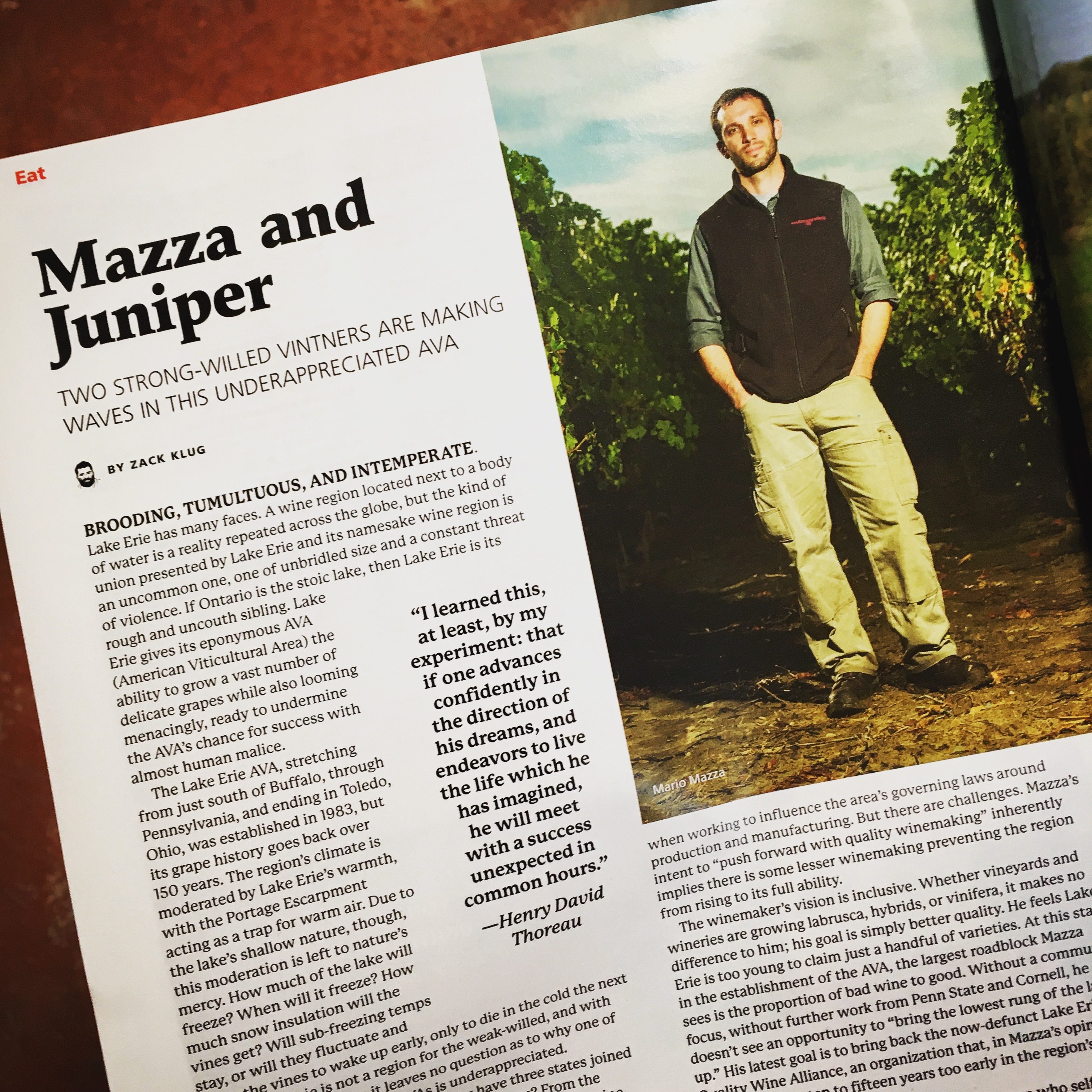Mazza and Juniper:
Two strong-willed vintners are making waves in this underappreciated AVA
BY ZACK KLUG
Buffalo Spree, December 2018
Brooding, tumultuous, and intemperate. Lake Erie has many faces. A wine region located next to a body of water is a reality repeated across the globe, but the kind of union presented by Lake Erie and its namesake wine region is an uncommon one, one of unbridled size and a constant threat of violence. If Ontario is the stoic lake, then Lake Erie is its rough and uncouth sibling. Lake Erie gives its eponymous AVA (American Viticultural Area) the ability to grow a vast number of delicate grapes while also looming menacingly, ready to undermine the AVA’s chance for success with almost human malice.
The Lake Erie AVA, stretching from just south of Buffalo, through Pennsylvania, and ending in Toledo, Ohio, was established in 1983, but its grape history goes back over 150 years. The region’s climate is moderated by Lake Erie’s warmth, with the Portage Escarpment acting as a trap for warm air. Due to the lake’s shallow nature, though, this moderation is left to nature’s mercy. How much of the lake will freeze? When will it freeze? How much snow insulation will the vines get? Will sub-freezing temps stay, or will they fluctuate and cause the vines to wake up early, only to die in the cold the next night? Lake Erie is not a region for the weak-willed, and with its youth and diversity, it leaves no question as to why one of America’s only multi-state AVAs is underappreciated.
If this lake is so unpredictable, why have three states joined together to make wine along its rugged shores? From the perspective of two prominent Lake Erie Wine Country wine growers, it is both their home and their history.
Mario Mazza’s family came to Northeastern Pennsylvania in the early 1960s to farm a small Concord vineyard. Their first vintage as a winery was in 1973, followed by forty-five more. He now oversees three wineries (South Shore Wine Co., Mazza-Chautauqua Cellars, and Mazza Vineyards), as well as a brewery and distillery (Five & 20). Mazza has been privileged to work with a diverse wine staff, including artisans from France, India, Uruguay, Portugal, and Germany. This worldly give and take has helped him realize exactly what Lake Erie is capable of.
It’s that potential that excites Mazza: potential for aromatic whites and obscure, cold-hardy reds. With sporadic weather, a penurious grape juice market, and progressively aimed—albeit slowly moving—laws and governance, Mazza sees a future for the Lake Erie AVA in high-end wine production. And this potential is defined in his focus—in the vineyard, in the community, and when working to influence the area’s governing laws around production and manufacturing. But there are challenges. Mazza’s intent to “push forward with quality winemaking” inherently implies there is some lesser winemaking preventing the region from rising to its full ability.
The winemaker’s vision is inclusive. Whether vineyards and wineries are growing labrusca, hybrids, or vinifera, it makes no difference to him; his goal is simply better quality. He feels Lake Erie is too young to claim just a handful of varieties. At this stage in the establishment of the AVA, the largest roadblock Mazza sees is the proportion of bad wine to good. Without a community focus, without further work from Penn State and Cornell, he doesn’t see an opportunity to “bring the lowest rung of the ladder up.” His latest goal is to bring back the now-defunct Lake Erie Quality Wine Alliance, an organization that, in Mazza’s opinion, was phased out ten to fifteen years too early in the region’s evolution.
Another Erie winemaker, Joe Juniper, is a man who self-describes as just a “boy from the trailer park.” Juniper comes from humble beginnings; his start in the industry occurred at the age of thirteen. He easily found affinity for growing vines, starting with manual labor in the vineyard, work he still enjoys. After working for many local vineyards, Juniper has become one of the most prominent producers in Ohio.
Ohio’s Vermilion Valley Vineyards got its start in 2007, thanks to a botanist, an MBA, and a landowner. Juniper worked in Vermillion’s vineyards and, after some growth and internal shuffling, in 2013, at the age of twenty-two, he and his wife took over operations. What was a small, eleven-acre winery has grown to a respectable fifty-one-acre operation with 110 additional acres allocated for future plantings. The winery utilizes 100 percent estate-grown fruit.
To say that Juniper has strong opinions wouldn’t do justice to his verbosity. The list of items keeping him disgruntled is long, but his priority is the current structure of the Ohio wine industry. With 850 acres under vine, 500 held by the state’s seven largest producers, and over 300 wineries in the state, there isn’t enough fruit to go around. The state has built its industry on agritourism, with many buying custom-crush wine from Washington/California. This causes dissonance with customers. Customers either expect Ohio wine to be California fruit, or worse, they drink the misleadingly labeled WA/CA custom crush wine, assuming it’s Ohio wine. This creates a qualitative style expectation that does not align with Ohio terroir. Juniper’s intent is to shine light on this controversy, so that true Ohio terroir can be honestly represented.
Juniper’s plans whirlwind from expanding on vineyard acreage (including a current project where he’ll drill holes into a limestone quarry for each individual vine) to carving out more sub-AVAs to searching for ways to respond to climate change (like lower impact varieties that require fewer sprays) to advancing tech in the vineyard (to avoid relying on a dwindling labor force). Not to mention selling wine to more than just Ohioans.
Juniper is a metaphorical arsonist, ready to burn down what he perceives to be holding Ohio’s Erie wines back so that he can work alongside others to build Ohio’s wine culture into what it deserves to be.
Given what we know about the region and its temperament, why would anyone choose to set roots in Lake Erie? Why would anyone choose to risk so much? This region, which is stuck between New York star children, Pennsylvanian vacationers, and Ohioan rockers is all tied together by an unpredictable and violent lake. With Mario Mazza as the altruistic sheriff and Joe Juniper as the fire of progress, one would be remiss to ignore what is and can be great about Lake Erie wines.

